There are different kinds of overdimension vehicles and loads, with different requirements
Example: A rigid truck that doesn't normally exceed the standard dimension limits but is being used to transport an overwidth tank or long load.
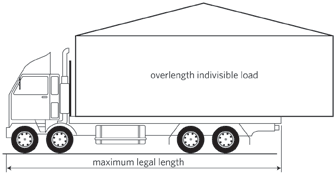
A standard motor vehicle may be used to transport an overdimension load provided that the load is indivisible, and is loaded in a way that minimises its width. (Unless the load's height or instability, or both, makes it necessary to transport the load sideways).
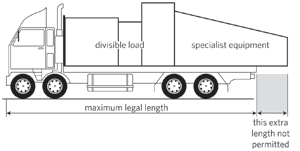
A standard motor vehicle may transport more than one overdimension load, if the loads:
aren’t wider than 2.55 metres if they’re loaded side by side
aren’t higher than 4.3 metres if they’re loaded one above the other
aren’t longer than the standard length or rear overhang limits for that vehicle if they’re loaded one behind the other.
The following combination motor vehicles can’t exceed the load standard rear overhang or overall length limits:
A truck and simple trailer
A truck and full trailer
An A-train truck.
A B-train truck.
Example: Chip spreaders, forklifts, mobile cranes, snow ploughs, ground spreaders/sprayers etc.
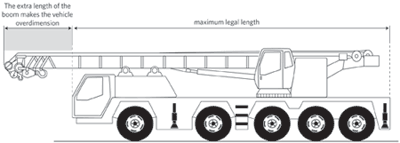
Specialist overdimension vehicles aren’t primarily designed to transport overdimension or overweight loads, but they can exceed the limits for standard vehicles if:
the vehicle’s primary purpose is to carry out a specialistfunction that requires overdimension equipment, and dismantling the vehicle’s overdimension equipment would make the vehicle unusable for its intended purpose, or
it would take more than four hours to dismantle the equipment.
A specialist overdimension motor vehicle may transport a divisible load, but it can’t exceed the maximum standard dimension limits if those limits can be complied with by reducing the size of the vehicle’s divisible load.
Example: Low loaders, three or four rows of eight transporters, multi-axle house trailers, platform trailers.
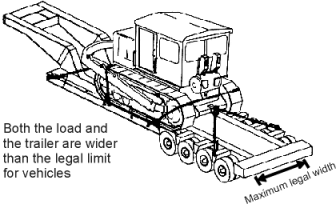 The following three scenarios show how these vehicles, commonly referred to as overdimension transporters, can be loaded.
The following three scenarios show how these vehicles, commonly referred to as overdimension transporters, can be loaded.
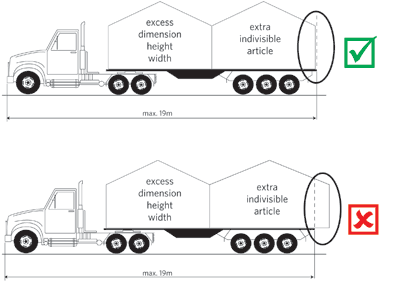
An overdimension transporter can carry an overdimension load if the load:
is indivisible, and
is loaded in a way that minimises its width (unless the load’s height or instability (or both) makes it necessary to transport the load sideways).
An overdimension transporter may transport more than one overdimension load if:
side by side, the total width isn’t greater than 2.55 metres
one above the other, the total load isn’t higher than 4.3 metres
one behind the other, the length, front overhang or rear overhang limits of a standard vehicle aren’t exceeded.
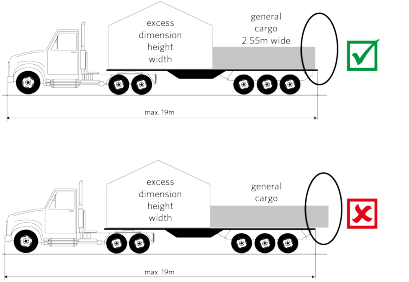
If an overdimension transporter is carrying an overdimension load and a divisible load (general freight), the overdimension transporter must be reduced to the smallest dimension practicable to carry the indivisible load.
This means that widening trailers must be closed to their narrowest width, and tromboning trailers must be reduced to their shortest forward distance.
Overdimension transporters may transport divisible goods if the goods:
side by side, don’t overhang the deck and the deck has been reduced to its smallest width
one above the other, aren’t higher than 4.3 metres, and
one behind the other, don’t overhang the deck and the deck has been reduced to its shortest length.
If an overdimension transporter is only carrying a divisible load (general freight) (ie, it isn’t transporting an overdimension load), the transporter must be reduced to the smallest dimension practicable. Widening trailers must be closed to their narrowest width, and tromboning trailers must be reduced to their shortest forward distance.
An overdimension transporter may transport divisible goods if:
one direction of the vehicle’s journey requires the overdimension vehicle to transport an overdimension load, or
the weight or instability of the divisible load requires the use of the overdimension motor vehicle.
If the two points above are true, then the three points below must also be met:
Side by side, the goods don’t overhang the deck and the deck has been reduced to its smallest width, and
One above the other, the goods aren’t higher than 4.3 metres, and
One behind the other, the goods don’t overhang the deck and the deck has been reduced to its smallest length.
|
Note: You cannot use a specialist overdimension trailer to carry divisible general freight that is not overdimension unless you have an overdimension load in the other direction. |
The operating requirements for overdimension vehicles depend on their width, length, forward distance, front overhang and rear overhang and height.
The graph below shows which category your vehicle and load fall into, based on the width and the forward distance.
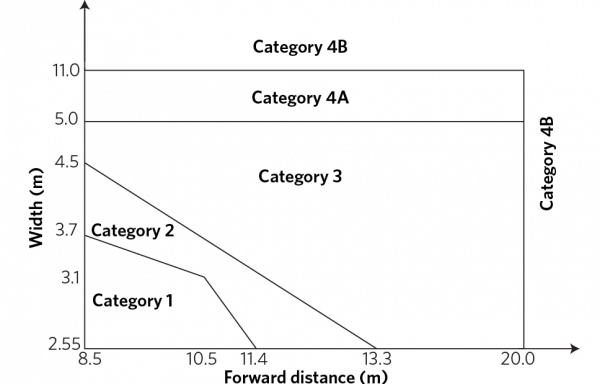
Use the graph to work out your vehicle category
Find the horizontal line on the graph that matches your vehicle’s width, and the vertical line that matches your vehicle’s forward distance. Where these two lines meet determines your category. (Work out the category for each vehicle in a combination, and follow the requirements for the highest category vehicle.)
Width and forward distance are only two of the five dimensions that determine if your vehicle or load is overdimension. Your vehicle or load will also fall into Category 1 if:
the length is over the maximum allowed for a standard vehicle (including combination vehicles), but not over 25 metres, or
the front overhang is over the maximum allowed for a standard vehicle, but not over 7 metres, or
the rear overhang is over the maximum allowed for a standard vehicle, but not over 7 metres.
Your vehicle or load will fall into Category 2 if:
the length is more than 25 metres but not more than 35 metres, or
the front overhang is more than 7 metres but not more than 10 metres, or
the rear overhang is more than 7 metres but not more than 10 metres.
If any dimension falls into Category 1 (and none in Category 2) then your vehicle falls in Category 1. Any dimension falling into Category 2 (and none in Category 3) puts your vehicle in Category 2.
If the vehicle or load is more than 35 metres long, or has a front overhang or rear overhang of more than 10 metres, then it falls in Category 3 or 4 and you need to contact OPIA.
Combinations falling on the upper boundary of Category 1 on the graph are treated as Category 1 loads, and those falling on the upper boundary of Category 2 on the graph are treated as Category 2 loads.
The operator of any load/vehicle that is more than 25 metres long has to get approval from the rail service operator e.g. KiwiRail if the load/vehicle is going to travel over a level crossing.
Find out more about getting approval on the KiwiRail website(external link)
An overdimension vehicle or load must have an overdimension permit, unless:
its width and forward distance combination are within Category 1 or 2 limits, and
it’s no higher than 5 metres, and
it doesn’t have a front overhang or rear overhang greater than 7 metres, and
it isn’t longer overall than 25 metres.
If your vehicle exceeds any of these dimensions, or has a width and forward distance combination that falls within Category 3 or Category 4 areas of the graph, then you must obtain a specific permit from the Overdimension Permit Issuing Agency (OPIA). Call us on 0800 OVERSIZE (0800 683 774) or fax 06 953 6313.
If they grant you a permit, you have to carry it in the vehicle when you’re travelling, and produce it for inspection by an operator of a pilot vehicle or an enforcement officer.
Find out more about applying for an overdimension permit
There are other requirements you also need to be aware of when driving or operating overdimension vehicles.
Find out more about driving overdimension vehicles
Find out more about the roles, responsibilities and permit requirements for overdimension loads
Download Factsheet 53a: Overdimension vehicles and loads [PDF, 1 MB]